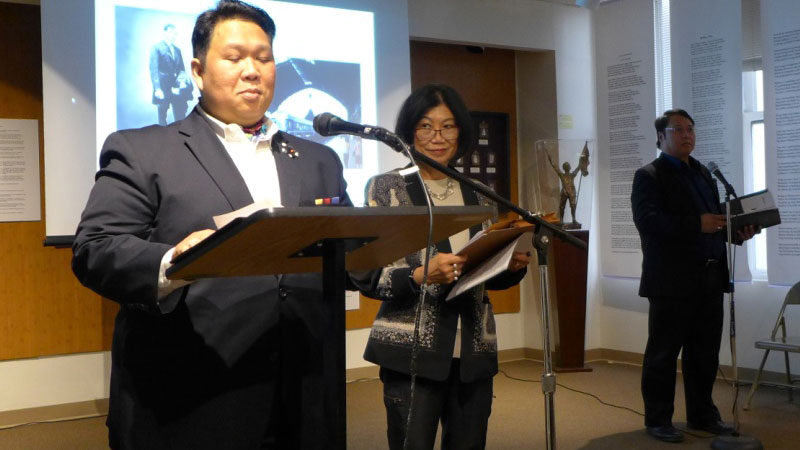
Dramatic reading of “A Kiss from Loleng,” from left to right: Dody Garcia as Rizal, Lydia de la Cruz as Loleng, Leon Palad as Silverio. CONTRIBUTED PHOTO
SAN FRANCISCO, California –Jose Rizal’s 153rd birth anniversary was the occasion for celebration of the Philippine national hero’s “personable side” when the Philippine Folklife Museum Foundation, a non-profit dedicated to the preservation and promotion of Filipino history and culture, staged a reading of a story attributed him.
“A Kiss from the Philippines,” published on July 15, 1890 in the La Solidaridad by the pseudonymous Taga-Ilog, became “A Kiss from Loleng” in the reading performed by Dody Garcia playing the role of Rizal, Leon Palad depicting Rizal’s friend Silverio, and Lydia de la Cruz, Philippine Folklife’s museum operation and development chair, playing Loleng (Leonor Rivera). Dr. Penelope V. Flores, PhD. provided the material.
“A Kiss from Loleng” is a romantic reminiscence of the evening Rizal bid farewell to his sweetheart Leonor Rivera (Loleng).
It starts with Rizal meeting his friend Silverio at the train station in Atocha Mediodia in Spain, who is bringing him news from the Philippines and, of course, from Loleng. Rizal’s memories of Loleng are filled with love and affection and thoughts of what happened on the last evening he spent with her in the Philippines. Rizal tried to get a kiss from her, promised everything he could possibly think of, but to his dismay never got the kiss.
Silverio has brought him a rose from Loleng, which she had for Rizal. Elated, Rizal kisses the rose only to belatedly learn that Silverio, tempted by the kiss from Loleng’s “wet lips,” had kissed it too. Humor ensues.
The Office of the Philippine Consulate General in San Francisco and the Philippine Center Management Board co-sponsored the commemoration at the Social Hall of the Philippine Consulate here.
Danny de la Cruz, president of the Philippine Folklife Museum Foundation gave a brief history and purpose of the museum. Consul Reginald Bernabe thanked the museum and the audience for enhancing and celebrating their linkages to their cultural and historical heritage. Consul Reichel Quiñones also graced the event.
Lydia de la Cruz said that on this occasion she wanted to “present a more personable side of
Dr. Jose Rizal,” as man in love, challenged, patient as captured in his love affair with Leonor Rivera. De la Cruz also read a short biography of Leonor Rivera.
Michael Gonzalez capped the evening with his classical guitar solo rendition of “Kundiman ni Rizal,” popularized by the Katipuneros, and “Tango ni Rizal, Gonzalez was a faculty member of the University of the Philippines.
The Philippine Consulate’s Social Hall features the Philippine Folklife Museum Foundation’s permanent exhibit including a series of 15 bas-relief wooden sculptures highlighting events throughout Philippine history, carved by well-known Philippine sculptor Luis Ac-Ac. Also on display are pineapple (piña) cloth items, including three elegant gowns circa 1936, gifts from the Philippine first lady Aurora Quezon, wife of President Manuel L. Quezon, to her friend, the late Mrs. Ann Schinazi.
The Philippine Folklife Museum Foundation constantly updates and expands their exhibits. In 2012 a permanent exhibit on Dr. Jose Rizal was inaugurated. The Rizaliana exhibit feature the hand carved bust of Dr. Jose Rizal by Luis Ac-Ac on a pedestal stand. Also on display are Rizal’s family tree with individual photo of Rizal’s parents and his eleven siblings in a Demure Damask mini black frame and the women that made a difference in Rizal’s life with each photo in a vintage jeweled ornate frame. A copy of the manuscript of Rizal’s two novels; “Noli Me Tangere” and “El Filibusterismo and the last poem written by Dr. Jose Rizal “ Mi Ultimo Adios” in Spanish, English and Tagalog printed on canvas and displayed in banner forms.
The latest addition is a statue of Andres Bonifacio in marble dust and resin with a bronze finish, an 18-inch replica of the Bonifacio Monument at Pugad Lawin by Anastacio Caedo, one of Philippine’s greatest sculptors, together with a black and white portrait of Andres Bonifacio beautifully framed in wood and glass centered with his biography .
Also available for viewing are the beautiful photos on canvas by photographer David Fabros.
These are the “Cry of Balintawak or Cry of Pugad Lawin”, depicting the beginning of the Philippine Revolution against Spain in 1896 led by Andres Bonifacio and “The Martyrdom of Rizal”, depicting his execution at Bagong Bayan (now Rizal Park) on December 30, 1896. Both
Photos were based on the original mural of Botong Francisco, Philippine National Artist for Visual Arts in 1973. A photo of Dr. Jose Rizal based on the original wood sculpture by Isabelo Tampico.
It is an opportunity to view the work of arts by famous Philippine sculptors, painters and learn the history of the Philippines right here in the City of San Francisco says Museum Operations & Development Chair Lydia S. de la Cruz. She invites the public to visit and make the museum a destination with friends and families. The museum is open Monday–Friday 10:00AM – 4:00PM.

